
Death of a monsterby Dwayne A. Day
|
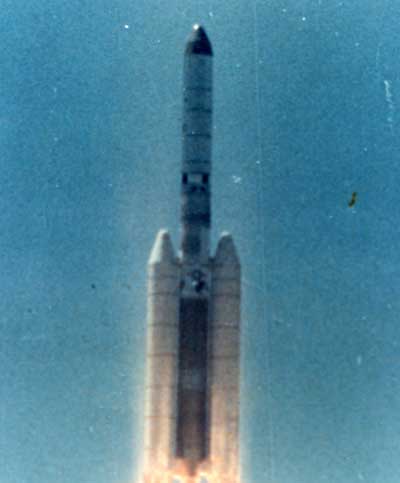 (credit: USAF) |
That was what remained of a Titan 34D rocket after it blew itself to smithereens only seconds after launch in April 1986 at Vandenberg Air Force Base on California’s central coast. Titans were not friendly rockets. Originally designed as ICBMs, they used storable liquid fuel that was also nasty. It could sit in the missile’s tanks in a silo for long periods of time, but if it escaped, the fumes could be deadly to anybody not wearing protective gear and breathing apparatus. The Titan was generally a reliable booster, but in its early days of testing in the 1960s missilemen referred to the Big F*#!^@ Red Cloud, or BFRC, whenever a Titan blew up (the deleted expletive is known to be a favorite of the—for now—governor of Illinois).
Not visible in all of those photos are the remains of the rocket’s highly classified payload. It was the last of its species, the final KH-9 HEXAGON reconnaissance satellite. As big as a Greyhound bus, when it debuted in 1971 it was so much larger than any previous spy satellite that those associated with it referred to the spacecraft as “the big bird,” a name that some people soon assumed was the actual designation for the satellite. The KH-9 had been wildly successful throughout the seventies and into the eighties. With only a few glitches along the way, KH-9 satellites had operated outstandingly well right from the start, despite the fact that according to everybody who worked on it, it was—and remains—the most complicated mechanical device ever launched into space. The Swiss make finely engineered watches; the Americans build finely engineered reconnaissance satellites. Now one lay in smoking pieces on the ground.
 (credit: USAF) |
This was a bad day.
But it was—and would continue to be—part of a pattern. The mid-eighties were a bad time for the American space program in general. Within a period of only two years, NASA and the Department of Defense lost four launch vehicles and payloads. The most tragic was of course the January 1986 destruction of the Space Shuttle Challenger and her seven-person crew. But in August 1985 the Air Force lost a KH-11 spy satellite atop a Titan 34D virtually identical to the one that blew up in April 1986. The month following the spectacular HEXAGON explosion, NASA lost a GOES-G weather satellite atop a Delta rocket, and in March 1987 the USAF lost a Navy Fleetsatcom communications satellite. The first half of 1986 was just a nonstop series of rocket failures: Challenger, Titan, Delta, boom boom boom. Magazines ran articles asking what was wrong with America’s space program, as if there was a single “program.”
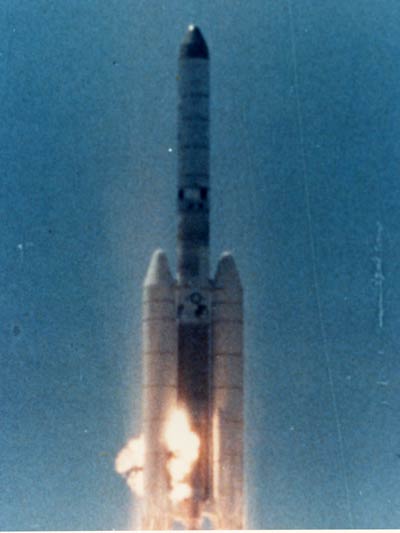 (credit: USAF) |
The losses were all distinct events in themselves. If there was any overarching cause, like a loss of systems engineering competence, or laziness and inattentiveness among American space program managers who had become over-confident, it was never identified by a single high-level review. The Challenger accident was attributed to serious mismanagement at NASA. The Air Force launch failures were not linked, although the military did change many procedures and beef up its safety and mission assurance programs in the wake of these accidents.
But before anybody could make corrections at the Air Force, they had to conduct an investigation. Some of those gathered to watch this final launch of the HEXAGON actually wept at the sight of their last baby falling in pieces back to the Earth rather than sailing into space. Later, when people started probing through the wreckage, they found ribbons of the KH-9’s reconnaissance film, approximately seven inches wide, blowing in the breeze.
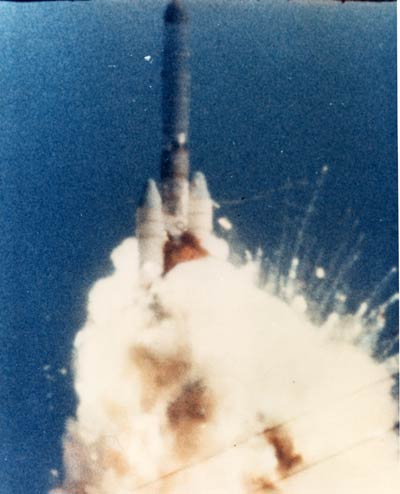 (credit: USAF) |
That search also turned up rifle shells in the surrounding hills, leading some to speculate that the rocket was downed by sabotage. But as with any rocket launch, the first thing investigators did was look at the telemetry tapes. The basic facts, later released in a declassified mishap report (that deleted the accident investigation’s conclusions) were that “anomalous conditions” began at 8.38 seconds after launch, engine shutdown was commanded at 15.53 seconds, and command destruct at 16.38 seconds. The vehicle impacted the ground at 28.44 seconds. Most of the debris fell within Space Launch Complex 4E, with burning chunks creating many small isolated fires within a half-mile radius. The pad damage was extensive, and some vehicles nearby were destroyed.
At first the investigators were tight-lipped. Contemporary press accounts did not contain much information on the cause of the explosion until several months later. The Titan’s solid rocket motors—like those on the Space Shuttle—were assembled in segments. What investigators discovered is that a bit of nitrile butadiene rubber (NBR) insulation, which surrounded the propellant and prevented the 2,760°C combustion from reaching the steel rocket case, came loose near a joint between two segments. This allowed the hot combustion gases and heat transfer to burn through the case. Destruction was rapid and complete.
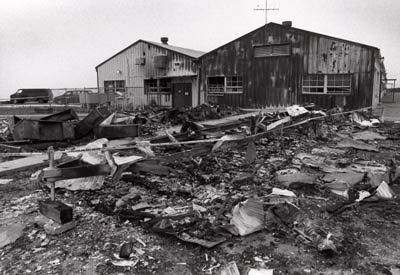 (credit: USAF) |
The biggest problem for the investigators was figuring out why the insulation came loose. Investigators examined many other rocket segments and did not find a similar problem. The problematic segment was five years old and investigators examined other segments that old and found no problem due to age. Ultimately, they determined that because they could not develop a design or procedural fix to prevent the insulation from coming apart on future launches, the solution was rigorous inspections and much better instrumentation on the rockets. It did not completely work, however: another Titan carrying a classified eavesdropping satellite a year or so later never reached its proper orbit. If there was a lesson to be learned, it was that the Titan was a difficult beast to tame.
That big ugly cloud also did some human damage. A letter written to the base commander a week after the explosion captured some of the drama. It was written by Martha Boise, who lived on the Hollister Ranch downwind of the explosion. Ms. Boise wrote: “Your rocket explosion last Friday, April 18th has affected my children. They were all exposed to the toxic cloud. They were not given the advantage of any warning or any information on the toxic material in the air surrounding them.” Ms. Boise wrote that her family had called Vandenberg twice about the air quality and the reply was that the base could not provide any information. She wanted to know why there had been no warning, what the toxic effects of the chemical cloud were, whether there was nuclear material on the rocket, who should they deal with, who should they call in event of a future explosion, and who would warn them the next time.
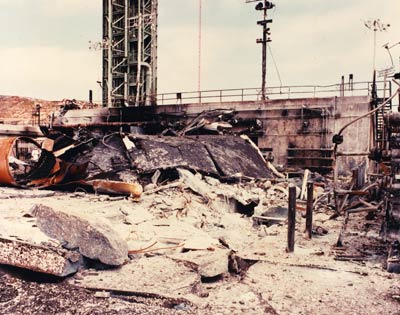 (credit: USAF) |
Apparently she got her answers, for Ms. Boise wrote the base commander a follow-up letter a couple of weeks later after a visit by some Air Force officers to reassure her that the military was taking the situation seriously, and had changed procedures about warning local residents in event of an emergency.
It was eighteen months before the Air Force launched another Titan with a new reconnaissance satellite. But this time it was a KH-11. There were no more KH-9s left, although the bones of one of them (actually a test model) still remains in a classified warehouse and may someday be displayed in a museum, like some ancient dinosaur that once orbited the Earth.